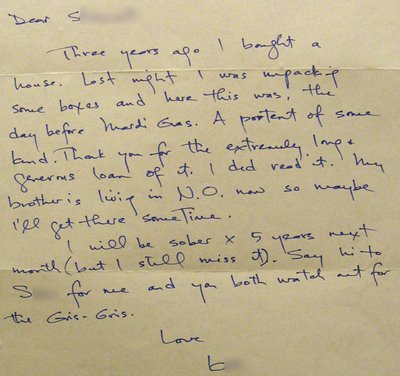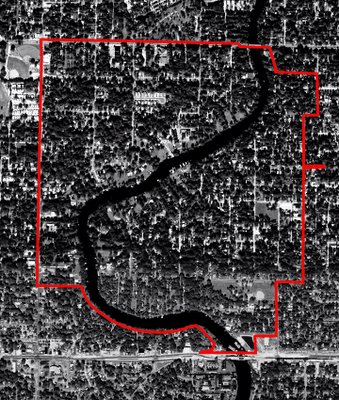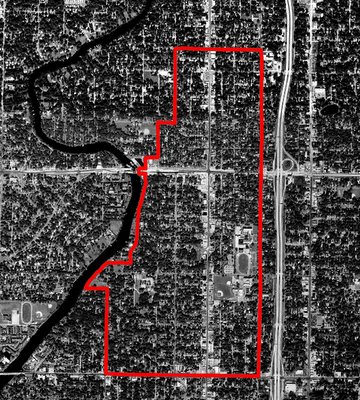click here to read The Marathon Post sequentially
It’s here, walking gingerly along the river in the long shadows of the late evening sun that I start to make some connections. The physical manifestations of river and city serve only as backdrops to the many dramas that have played across their stages. As the evacuation of New Orleans finally began, each commandeered school bus took with it pieces of the city that would not return without being changed, if they were to return at all. For months the vibrant, eclectic, and quintessentially American culture of New Orleans came to a halt while its participants scattered across the country to experience new environments and rituals, and to alter those destinations with their presence in much the same way that the Mariel boatlift had changed the face of South Florida twenty-five years ago. The months-long abandonment of New Orleans would have been enough to alter its unique character forever, but the storm’s destruction had erased many of the physical reminders needed to jog the memories of its former occupants on their return.
The experience of New Orleans or Tampa or any other city is immersive, temporal, and elusive: a leaf in the stream of the city’s people, history, geography, and culture. The city’s personality, like that of a man, is a product of these competing and ever-changing forces that can never again be duplicated. Just as a man’s DNA can theoretically be extracted to produce “exact replicas” of himself, the infinitely complex set of influences that created his personality can never be reproduced. In New Orleans this scenario was multiplied by the hundreds of thousands. Katrina dragged her hand slowly through the ant trail of New Orleans, and its occupants had lost the scent and scattered.
The plane to New Orleans had been crowded with hard-hat-toting construction workers, project managers, and government-official-types, each with their own concept of what New Orleans was and, more importantly, what it would become. Most of their ideas had originated in far-flung government offices and had little or no relation to the city of New Orleans, its people, and their unique set of circumstances.
All of my life’s most memorable experiences have started well before dawn. From childhood fishing trips with my father to college road trips, touring with the band, backpacking, and mountain climbing; it seems like anything worth doing requires the use of multiple alarm clocks and a coffee maker that is pre-loaded and ready to go. The morning of February 26th, 2006 is no different. Like some sort of numerologist’s dream, I have chosen to run 26.2 miles on 02-26-2006.
At three o’clock I awake and start my now-familiar long run ritual. Drink thirty-two ounces of water standing naked in the dark at the kitchen sink. Turn on the kettle and see the room lit only by the blue flame of the gas burner. Shower by candlelight. The thought of the kettle boiling away on the stove helps to keep me from luxuriating in the shower’s warmth for too long. Still wrapped in my towel, I pour the steaming water into the French press and stir with a wooden spoon stained a dark brown to the middle of its handle from years of this routine. I turn up the dimmer in the kitchen, letting my eyes adjust gradually to the light. As the coffee steeps, I dress myself slowly. First comes the BodyGlide; a generous coat applied to any surface that might even think about blistering or chafing, then I powder my feet and slather my upper body in sunscreen. My clothes are laid out on the dresser like a seven-year-old on his first day of school, and I slip into them quietly while Jan sleeps. I take my shoes and socks out to the couch and sit down, deliberately lining up each seam over my toes, making sure that everything lies flat and straight. There is something about the act of putting on my shoes that always gets me lost in thought. Somehow, this final act in my morning ritual sets me to thinking about what lies ahead and I sit, one shoe on and the other in hand, “locked in a stare” as Jan would say. I’ve done this all my life, and I’m not the only one in the family. A week ago I watched my brother do the same thing as he got ready for an early flight back to California. Coming to, I think of the nursery rhyme that my stepmother would tease me with as a child, “Diddle, diddle, dumpling, my son John/ Went to bed with his stockings on/ One shoe off, and one shoe on/ Diddle, diddle, dumpling, my son John.”
A large portion of marathon training, I have come to believe, is not directly related to the physical act of running. There are certain adjustments that one’s body must make in terms of metabolism, pacing, stamina, and overall tolerance for abuse, but the vast majority of what is accomplished in the months of training is a little harder to quantify. It is only through constant repetition that the runner begins to gain control over the more subtle and less conscious elements of their performance. The “involuntary” smooth muscles of the digestive tract begin to obey signals from the rest of the body, and on mornings before a long run there is a cleansing that takes place as the body tries to free itself of all unnecessary baggage before embarking on the journey ahead. I have experienced this effect several times now and it has become part of my pre-run ritual, but the last few days have been slightly different. Something inside of me knows that today’s race carries with it the weight of all my previous efforts, and this has manifested itself as a week-long obsession. I have an insatiable desire to do the three things that, according to Lenny Bruce, led to the first laws of civilization: Eat, Sleep, and Crap. I’m locked in the grip of a full-body peristalsis, and I can’t seem to get enough.
It’s here, walking gingerly along the river in the long shadows of the late evening sun that I start to make some connections. The physical manifestations of river and city serve only as backdrops to the many dramas that have played across their stages. As the evacuation of New Orleans finally began, each commandeered school bus took with it pieces of the city that would not return without being changed, if they were to return at all. For months the vibrant, eclectic, and quintessentially American culture of New Orleans came to a halt while its participants scattered across the country to experience new environments and rituals, and to alter those destinations with their presence in much the same way that the Mariel boatlift had changed the face of South Florida twenty-five years ago. The months-long abandonment of New Orleans would have been enough to alter its unique character forever, but the storm’s destruction had erased many of the physical reminders needed to jog the memories of its former occupants on their return.
The experience of New Orleans or Tampa or any other city is immersive, temporal, and elusive: a leaf in the stream of the city’s people, history, geography, and culture. The city’s personality, like that of a man, is a product of these competing and ever-changing forces that can never again be duplicated. Just as a man’s DNA can theoretically be extracted to produce “exact replicas” of himself, the infinitely complex set of influences that created his personality can never be reproduced. In New Orleans this scenario was multiplied by the hundreds of thousands. Katrina dragged her hand slowly through the ant trail of New Orleans, and its occupants had lost the scent and scattered.
The plane to New Orleans had been crowded with hard-hat-toting construction workers, project managers, and government-official-types, each with their own concept of what New Orleans was and, more importantly, what it would become. Most of their ideas had originated in far-flung government offices and had little or no relation to the city of New Orleans, its people, and their unique set of circumstances.
All of my life’s most memorable experiences have started well before dawn. From childhood fishing trips with my father to college road trips, touring with the band, backpacking, and mountain climbing; it seems like anything worth doing requires the use of multiple alarm clocks and a coffee maker that is pre-loaded and ready to go. The morning of February 26th, 2006 is no different. Like some sort of numerologist’s dream, I have chosen to run 26.2 miles on 02-26-2006.
At three o’clock I awake and start my now-familiar long run ritual. Drink thirty-two ounces of water standing naked in the dark at the kitchen sink. Turn on the kettle and see the room lit only by the blue flame of the gas burner. Shower by candlelight. The thought of the kettle boiling away on the stove helps to keep me from luxuriating in the shower’s warmth for too long. Still wrapped in my towel, I pour the steaming water into the French press and stir with a wooden spoon stained a dark brown to the middle of its handle from years of this routine. I turn up the dimmer in the kitchen, letting my eyes adjust gradually to the light. As the coffee steeps, I dress myself slowly. First comes the BodyGlide; a generous coat applied to any surface that might even think about blistering or chafing, then I powder my feet and slather my upper body in sunscreen. My clothes are laid out on the dresser like a seven-year-old on his first day of school, and I slip into them quietly while Jan sleeps. I take my shoes and socks out to the couch and sit down, deliberately lining up each seam over my toes, making sure that everything lies flat and straight. There is something about the act of putting on my shoes that always gets me lost in thought. Somehow, this final act in my morning ritual sets me to thinking about what lies ahead and I sit, one shoe on and the other in hand, “locked in a stare” as Jan would say. I’ve done this all my life, and I’m not the only one in the family. A week ago I watched my brother do the same thing as he got ready for an early flight back to California. Coming to, I think of the nursery rhyme that my stepmother would tease me with as a child, “Diddle, diddle, dumpling, my son John/ Went to bed with his stockings on/ One shoe off, and one shoe on/ Diddle, diddle, dumpling, my son John.”
A large portion of marathon training, I have come to believe, is not directly related to the physical act of running. There are certain adjustments that one’s body must make in terms of metabolism, pacing, stamina, and overall tolerance for abuse, but the vast majority of what is accomplished in the months of training is a little harder to quantify. It is only through constant repetition that the runner begins to gain control over the more subtle and less conscious elements of their performance. The “involuntary” smooth muscles of the digestive tract begin to obey signals from the rest of the body, and on mornings before a long run there is a cleansing that takes place as the body tries to free itself of all unnecessary baggage before embarking on the journey ahead. I have experienced this effect several times now and it has become part of my pre-run ritual, but the last few days have been slightly different. Something inside of me knows that today’s race carries with it the weight of all my previous efforts, and this has manifested itself as a week-long obsession. I have an insatiable desire to do the three things that, according to Lenny Bruce, led to the first laws of civilization: Eat, Sleep, and Crap. I’m locked in the grip of a full-body peristalsis, and I can’t seem to get enough.


















